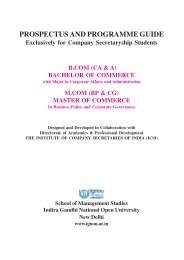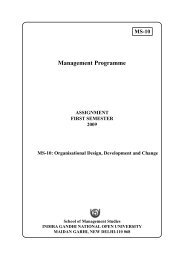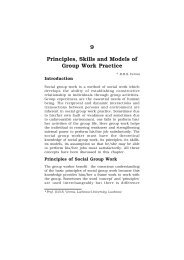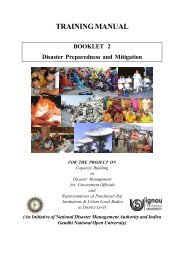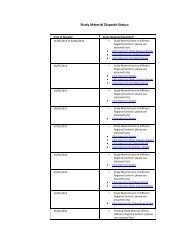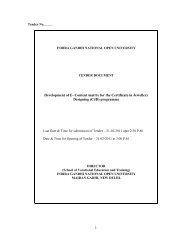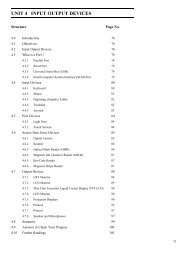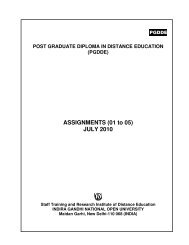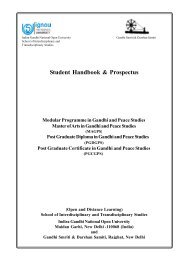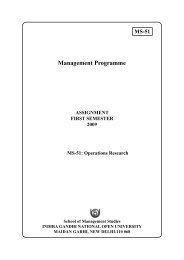Unit 4 refrigerants - IGNOU
Unit 4 refrigerants - IGNOU
Unit 4 refrigerants - IGNOU
You also want an ePaper? Increase the reach of your titles
YUMPU automatically turns print PDFs into web optimized ePapers that Google loves.
UNIT 4 REFRIGERANTS<br />
Structure<br />
4.1 Introduction<br />
Objectives<br />
4.2 Primary and Secondary Refrigerants<br />
4.3 Classification of Refrigerants<br />
4.4 Designation of Refrigerants<br />
4.5 Desirable Properties of Refrigerants<br />
4.5.1 Thermodynamic Properties<br />
4.5.2 Chemical Properties<br />
4.5.3 Physical Properties<br />
4.5.4 Safety Criteria<br />
4.5.5 Economic Criteria<br />
4.6 Common Refrigerants<br />
4.7 Ozone Depletion Potential and Global Warming Potential<br />
4.8 Secondary Refrigerants<br />
4.9 Illustrative Problems<br />
4.10 Summary<br />
4.11 Answers to SAQs<br />
4.1 INTRODUCTION<br />
The working agent in a refrigerating system that absorbs carries or releases heat<br />
from the place to be cooled or refrigerated can be termed as a refrigerant. This<br />
heat transfer generally takes place through a phase change of the refrigerant. A<br />
more complete definition of a refrigerant could be given as follows:<br />
“Refrigerant is the fluid used for heat transfer in a refrigerating system that<br />
absorbs heat during evaporation from the region of low temperature and<br />
pressure, and releases heat during condensation at a region of higher<br />
temperature and pressure.”<br />
Objectives<br />
In this unit, we shall learn about the different <strong>refrigerants</strong> used in various<br />
refrigeration systems. At present, we have a large number of <strong>refrigerants</strong> available<br />
to us depending on the requirements of the particular refrigerating system. A<br />
detailed study of these <strong>refrigerants</strong> has thus become imperative. This unit is<br />
intended to serve as an introductory guide to the study of <strong>refrigerants</strong>.<br />
After studying this unit, you should be able to learn<br />
<br />
<br />
<br />
<br />
the different classifications of <strong>refrigerants</strong>,<br />
naming convention for <strong>refrigerants</strong>,<br />
properties of individual <strong>refrigerants</strong>, and<br />
environmental effects related to the use of these <strong>refrigerants</strong>.
Refrigeration and Air<br />
Conditioning<br />
4.2 PRIMARY AND SECONDARY REFRIGERANTS<br />
Primary <strong>refrigerants</strong> are those which can be directly used for the purpose of<br />
refrigeration. If the refrigerant is allowed to flow freely into the space to be<br />
refrigerated and there is no danger of possible harm to human beings, then<br />
primary <strong>refrigerants</strong> are used. The <strong>refrigerants</strong> used in home refrigerators like<br />
Freon-12 are primary <strong>refrigerants</strong>.<br />
On the other hand, there may be certain situations in which we cannot allow the<br />
refrigerant to come in direct contact with the items being refrigerated, and then<br />
the refrigerant used is termed as a secondary refrigerant. As for example, we<br />
cannot allow a toxic refrigerant to be used for air conditioning in residential<br />
buildings. There are some <strong>refrigerants</strong> which are highly inflammable and so their<br />
direct use is forbidden for safety reasons. Again, it may so happen that if direct<br />
refrigeration, such as in cooling a big cold storage, is allowed, then the amount of<br />
refrigerant required may be so large that its cost becomes prohibitively high.<br />
These are some typical situations for which we favour the use of secondary<br />
<strong>refrigerants</strong>. Water and brine solutions are common examples of secondary<br />
<strong>refrigerants</strong>.<br />
4.3 CLASSIFICATION OF REFRIGERANTS<br />
Refrigerants can be broadly classified based on the following:<br />
Working Principle<br />
Under this heading, we have the primary or common <strong>refrigerants</strong> and the<br />
secondary <strong>refrigerants</strong>.<br />
The primary <strong>refrigerants</strong> are those that pass through the processes of<br />
compression, cooling or condensation, expansion and evaporation or<br />
warming up during cyclic processes. Ammonia, R12, R22, carbon dioxide<br />
come under this class of <strong>refrigerants</strong>.<br />
On the other hand, the medium which does not go through the cyclic<br />
processes in a refrigeration system and is only used as a medium for heat<br />
transfer are referred to as secondary <strong>refrigerants</strong>. Water, brine solutions of<br />
sodium chloride and calcium chloride come under this category.<br />
Safety Considerations<br />
Under this heading, we have the following three sub-divisions.<br />
Safe <strong>refrigerants</strong><br />
These are the non-toxic, non-flammable <strong>refrigerants</strong> such as R11,<br />
R12, R13, R14, R21, R22, R113, R114, methyl chloride, carbon<br />
dioxide, water etc.<br />
Toxic and moderately flammable<br />
Dichloroethylene methyl format, ethylchloride, sulphur dioxide,<br />
ammonia etc. come under this category.<br />
Highly flammable <strong>refrigerants</strong><br />
The <strong>refrigerants</strong> under this category are butane, isobutene, propane,<br />
ethane, methane, ethylene etc.<br />
Chemical Compositions<br />
They are further sub-divided as<br />
54
Halocarbon compounds<br />
These are obtained by replacing one or more hydrogen atoms in<br />
ethane or methane with halogens.<br />
Azeotropes<br />
These are the mixtures of two or more <strong>refrigerants</strong> and behave as a<br />
compound.<br />
Oxygen and Nitrogen Compounds<br />
Refrigerants having either oxygen or nitrogen molecules in their<br />
structure, such as ammonia, are grouped separately and have a<br />
separate nomenclature from the halogenated <strong>refrigerants</strong>.<br />
Cyclic organic Compounds<br />
The compounds coming under this class are R316, R317 and R318.<br />
Inorganic Compounds<br />
These are further divided into two categories: Cryogenic and Noncryogenic.<br />
Cryogenic fluids are those which are applied for achieving<br />
temperatures as low as – 160 0 C to – 273 0 C. Above this temperature<br />
range, we can use a multi-stage refrigeration system to realise the<br />
desired temperature. But below – 160 0 C, this is not possible since the<br />
COP of the cycle becomes very low. To attain temperatures below –<br />
160 0 C, we use <strong>refrigerants</strong> such as nitrogen, oxygen, helium,<br />
hydrogen etc. and for temperatures close to – 273 0 C, magnetic<br />
cooling is employed.<br />
The inorganic compounds which are employed above the cryogenic<br />
temperature ranges come under the remaining sub-division of<br />
inorganic <strong>refrigerants</strong>.<br />
Unsaturated Compounds<br />
Compounds such as ethylene, propylene etc. are grouped under this<br />
head and grouped under the 1000 series for convenience.<br />
Miscellaneous<br />
This group contains those compounds which cannot be grouped under<br />
the other components. They are indicated by the 700 series with the<br />
last numbers being their molecular weight. Examples include air,<br />
carbon dioxide, sulphur dioxide etc.<br />
As we can see from the above sub-divisions, they are not mutually<br />
exclusive. A compound may come under more than one sub-division.<br />
Hence, the importance of adopting the various naming conventions to<br />
designate the different <strong>refrigerants</strong> cannot be underestimated.<br />
Refrigerants<br />
4.4 DESIGNATION OF REFRIGERANTS<br />
The American Society of Refrigerating Engineers (ASRE) has developed certain<br />
conventions for use in naming different types of <strong>refrigerants</strong>. These naming<br />
conventions differ according to the type of refrigerant. Each refrigerant type is<br />
denoted by a different series. Thus, we have separate series for halogenated<br />
<strong>refrigerants</strong> and other types. The naming conventions are simple and easy to<br />
55
Refrigeration and Air<br />
Conditioning<br />
follow. These conventions are now accepted worldwide and help to name the<br />
large variety of <strong>refrigerants</strong> available commercially nowadays.<br />
Halocarbon Compounds<br />
These are represented by a three digit nomenclature. Here, the first digit<br />
represents the number of carbon atoms in the compound minus one, the<br />
second digit stands for the number of hydrogen atoms plus one while the<br />
third digit stands for the number of fluorine atoms. The remaining atoms are<br />
chlorine.<br />
As an example, let us consider the refrigerant having R22 as its three digit<br />
nomenclature.<br />
According to the above mentioned convention,<br />
No. of C atoms in R22: C – 1 = 0 => C = 1<br />
No. of H atoms in R22: H + 1 = 2 => H = 1<br />
No. of F atoms in R22: F = 2<br />
Since there is only one carbon atom in the compound, this compound has<br />
originated from the methane series (CH 4 ). From the calculation, we can see<br />
there is one hydrogen atom and two fluorine atoms. The remaining valence<br />
bond of carbon will be balanced by chlorine. Thus, the substance is<br />
Figure 4.1 Graphical Representation of Monochloro-Difluoro-Methane<br />
Therefore, chemical formula of R22 is CHClF 2 and has the name<br />
Monochloro-difluoro-methane (figure. 4.1).<br />
Taking again the example of R134, we can calculate its chemical formula as<br />
above which gives us<br />
No. of C atoms: C – 1 = 1 => C = 2<br />
No. of H atoms: H + 1 = 3 => H = 2<br />
No. of F atoms: F = 4<br />
Therefore, no. of Cl atoms: Cl = 0<br />
Figure 4.2 Graphical Representation of Tetrafluoroethane<br />
The compound is C 2 H 2 F 2 and its name is Tetrafluoroethane (Figure. 4.2).<br />
The non-halogenated <strong>refrigerants</strong> follow a different naming convention<br />
which is dependant upon the series of the refrigerant.<br />
56
4.5 DESIRABLE PROPERTIES OF REFRIGERANTS<br />
Refrigerants<br />
The vast number of <strong>refrigerants</strong> available in the market today allows us to choose<br />
a refrigerant depending upon the operating conditions of the refrigeration system.<br />
As such, there is no refrigerant that can be advantageously used under all<br />
operating conditions and in all types of refrigeration systems. In spite of that, we<br />
can state certain desirable properties that a refrigerant should posses. These<br />
properties can be divided into favourable thermodynamic, chemical and physical<br />
properties:<br />
4.5.1 Thermodynamic Properties<br />
Critical Temperature and Pressure<br />
The critical temperature of the refrigerant should be as high as possible<br />
above the condensing temperature in order to have a greater heat transfer at<br />
a constant temperature. If this is not taken care of, then we will have<br />
excessive power consumption by the refrigeration system.<br />
The critical pressure should be moderate and positive. A very high pressure<br />
will make the system heavy and bulky whereas in case of very low<br />
pressures, there is a possibility of air leaking into the refrigerating system.<br />
Specific Heat<br />
The specific heat of the liquid should be as small as possible. This ensures<br />
that the irreversibilities associated with throttling are small and there is<br />
greater subcooling of the liquid. On the other hand, the specific heat of<br />
vapor should be high to have less superheating of the vapor.<br />
Enthalpy of Vaporization<br />
This should be as large as possible to minimize the area under superheat and<br />
the area reduction due to throttling. Also, the higher value of enthalpy of<br />
vaporization lowers the required flow rate per ton of refrigeration.<br />
Taking these three factors into account, the T-s and p-h diagrams of an ideal<br />
refrigerant would be as shown in Figures. 4.3 (a) and 4.3 (b).<br />
T<br />
p<br />
3<br />
2<br />
3 2<br />
4<br />
1<br />
4<br />
1<br />
Figure 4.3(a) T-S Plot of an Ideal<br />
Refrigerant<br />
Figure 4.3( b) p-h Plot of an Ideal<br />
Refrigerant<br />
These properties are practically not found in any refrigerant. So, a trade-off<br />
has to be done in order to achieve as high a COP as possible.<br />
Conductivity<br />
s<br />
The conductivity of the refrigerant should be as high as possible so that the<br />
size of the evaporator and condenser is manageable. From this viewpoint,<br />
ammonia has a better conductivity than that of R12 or R22 and is more<br />
h<br />
57
Refrigeration and Air<br />
Conditioning<br />
suitable than the latter. But, ammonia is toxic and this does not allow its use<br />
in home refrigeration systems.<br />
Evaporator and Condenser Pressure<br />
Both the evaporator and condenser pressures need to be above atmospheric<br />
pressure otherwise there is a possibility of air leaking into the system.<br />
Presence of air drastically reduces the capacity of the refrigeration system.<br />
Also, due to presence of moisture in air, acids or other corrosive compounds<br />
may form and this may affect the tubing of the refrigeration system.<br />
Compression Ratio<br />
The compression ratio needs to be as small as possible otherwise the<br />
leakage of refrigerant occurs across the piston. Also, the volumetric<br />
efficiency is affected.<br />
Freezing Point<br />
It should be as low as possible or else there will be a possibility of blockage<br />
of passages during flow of fluid through evaporator.<br />
Volume of Refrigerant Handled Per Ton of Refrigeration<br />
This should be as small as possible in order to have a small size of the<br />
compressor. The type of compressor is decided by this value. For<br />
<strong>refrigerants</strong> like R12, R500, R22 etc., a reciprocating compressor is<br />
suitable. For others like R11 and water, a centrifugal compressor is required<br />
to handle the large volume.<br />
Coefficient of Performance<br />
Density<br />
The Coefficient of performance or COP has a direct bearing on the running<br />
cost of the refrigeration system. Higher the magnitude of COP, lower will<br />
be the running cost. Since, the COP of any refrigeration system is limited by<br />
the Carnot COP, for large operating pressures a multi-stage refrigeration<br />
system should be employed. CO 2 has a very low COP. Hence, it is not<br />
suitable for use as a refrigerant.<br />
The density of the refrigerant should be as large as possible. In<br />
reciprocating compressors, the pressure rise is accomplished by squeezing<br />
the entrapped fluid inside the piston-cylinder assembly. Hence, density<br />
decides the size of the cylinder. Again in centrifugal compressors pressure<br />
rise is related to the density of the vapor. A high value of density results in<br />
high pressure rise.<br />
Compression Temperature<br />
Whenever a refrigerant gets compressed, there is a rise in the temperature of<br />
the refrigerant resulting in the heating of the cylinder walls of the<br />
compressor. This necessitates external cooling of the cylinder walls to<br />
prevent volumetric and material losses. Refrigerants having lowest<br />
compression temperatures are thus better than others.<br />
4.5.2 Chemical Properties<br />
Chemical Stability and Inertness<br />
It should be chemically stable for the operating ranges of temperature. Also,<br />
it should not react with the materials of the refrigeration system or with<br />
which it comes into contact. Further, it should be chemically inert and must<br />
58
not undergo polymerization reactions at either the lower or higher ranges of<br />
temperatures.<br />
Action on Rubber or Plastics<br />
Rubber and plastics are used extensively in the refrigeration system. These<br />
materials are mostly used in the seals and gaskets of the refrigeration<br />
system. They help to prevent the leakage of the refrigerant and ensure the<br />
smooth functioning of the compressor. The refrigerant should not react with<br />
them or else there might be leakage of refrigerant from the system or loss of<br />
functioning of the compressor.<br />
Flammability<br />
The refrigerant should be inert and not catch fire when subjected to high<br />
temperatures. From this viewpoint CO 2 is the most suitable as it is not only<br />
non-flammable, but also acts as a fire-extinguisher. Ethane, butane,<br />
isobutene are highly undesirable as they catch fire quickly.<br />
Effect on Oil<br />
The refrigerant should not react with the lubricating oil else, there is a<br />
possibility of loss of lubricating action due to either thickening or thinning<br />
of the oil. It should not be soluble in the oil else there will be reduction in<br />
the viscosity of the lubricating oil.<br />
Effect on Commodity<br />
Toxicity<br />
If the refrigerant is directly used for chilling, then it should not affect the<br />
commodity kept in the conditioned space. Also, in case where direct cooling<br />
is not employed, the refrigerant should still not affect the commodity if<br />
there is any leakage.<br />
The refrigerant used in air conditioning, food preservation etc. should not be<br />
toxic as they will come into contact with human beings.<br />
4.5.3 Physical Properties<br />
Leakage and Detection<br />
Since pressures higher than atmospheric are usually employed in<br />
refrigeration systems, there is a possibility of leakage of <strong>refrigerants</strong> after<br />
long period of operation. It is desirable to detect this leak early else the<br />
system would operate under reduced capacity or stop functioning<br />
altogether. Hence, it is desirable that the refrigerant has a pungent smell so<br />
that its leakage can be detected immediately.<br />
Miscibility with Oil<br />
Viscosity<br />
The refrigerant should not be miscible with the oil else the lubricating<br />
strength will be reduced.<br />
It should be as small as possible to ensure that the pressure drop in the<br />
system is as small as possible. A low viscosity refrigerant will require less<br />
energy for its circulation through the refrigeration system.<br />
4.5.4 Safety Criteria<br />
Under safety criteria, we consider the toxicity, flammability, action on perishable<br />
food and formation of explosive compound on exposure to air. An ideal<br />
Refrigerants<br />
59
Refrigeration and Air<br />
Conditioning<br />
refrigerant should be non-toxic, non-flammable, have no effect on food products<br />
and should not react with atmospheric air. No refrigerant satisfy these criteria<br />
fully. We can therefore, group <strong>refrigerants</strong> into different sub-groups based on<br />
their flammability and toxicity levels.<br />
4.5.5 Economic Criteria<br />
Apart from the thermodynamic, chemical, physical and safety criteria, there is<br />
another criterion by which we judge an ideal refrigerant. The economic criterion<br />
takes into account the cost of the refrigerant, the availability and supply levels of<br />
the refrigerant, cost of storage and handling. We discuss each of these in detail<br />
below.<br />
Cost of Refrigerant<br />
The cost of the refrigerant has a big impact on the overall cost of the<br />
refrigeration system. Hence, its cost should be as low as possible. From this<br />
viewpoint, ammonia and water are ideally suited, but their low<br />
thermodynamic and chemical properties restrict their use in all types of<br />
refrigeration systems. Particularly, for flooded type evaporator or<br />
condenser, the refrigerant amount required is high and their cost needs to be<br />
factored in while making the initial investments.<br />
Availability and Supply<br />
The refrigerant should be easily available in the market and in abundant<br />
quantity. This ensures that the cost of the refrigerant is not prohibitive. An<br />
abundant and free supply of the refrigerant ensures that refrigeration<br />
systems will be designed specifically for use with them.<br />
Storage and Handling<br />
The refrigerant should be such that it can be conveniently stored and<br />
handled during transportation and charging. It should be stored in as small a<br />
pressure vessel as possible. Also, if we have to handle a toxic or flammable<br />
refrigerant, then the cost involved will be higher compared to handling and<br />
storage cost of non-toxic and non-flammable refrigerant.<br />
From the above discussions of the ideal properties of <strong>refrigerants</strong>, we can<br />
come to the conclusion that none of the <strong>refrigerants</strong> in current use and<br />
available satisfy these conditions fully. As such, we have to make a detailed<br />
analysis of the different factors like cost, performance of the refrigeration<br />
system and safety issues before deciding on using a particular refrigerant.<br />
4.6 COMMON REFRIGERANTS<br />
The <strong>refrigerants</strong> which are available commercially in the market are numerous.<br />
Some of them which are in common use are mentioned below:<br />
Air<br />
Air (molecular weight 28.97, specific heats c p = 1.04 kJ/kgK and c v = 0.712<br />
kJ/kg-K) is one of the earliest refrigerant to be used in the refrigeration<br />
systems. Its advantages are that it is available free of cost, is non-toxic and<br />
non-flammable and does not affect the commodity if pure. However, air<br />
suffers from a number of drawbacks. Air contains moisture and this reacts<br />
with the material of the evaporator and condenser severely affecting their<br />
working capacity. Further, there is a possibility that the passages may be<br />
blocked by the formation of ice from this moisture. The COP of air is of the<br />
order of 0.6 and thus, not suitable for use in refrigeration systems on a<br />
60
Ammonia<br />
commercial scale. It is mainly used for air conditioning in aircrafts where<br />
efficiency of operation is of secondary importance.<br />
Ammonia (molecular weight 17) is one of the oldest <strong>refrigerants</strong> and it was<br />
commonly employed in places where toxicity effects were of secondary<br />
importance. Its advantages are its low cost, low specific volume, high COP<br />
(of the order of 4.0) and high refrigeration effect per unit mass of the<br />
refrigerant. Its primary drawback is its toxicity which prevents its use in airconditioning<br />
and food preservation systems. Ammonia has a boiling point<br />
of -33 0 C at atmospheric pressure.<br />
Carbon Dioxide<br />
Carbon dioxide (molecular weight 44) is a non-toxic and non-poisonous<br />
refrigerant. Also, it is not only non-flammable but and is an excellent<br />
extinguishing agent as well. Its other advantages are that it is chemically<br />
stable, immiscible with the lubricating oil and does not affect the metal used<br />
in the system. It has a low specific volume and this requires volume<br />
displacement per ton of refrigeration. However, its critical pressure is too<br />
high. Also, its critical temperature is only 31 0 C which makes it unsuitable<br />
for use in countries with a hot climate like India. It is an excellent<br />
refrigerant for low temperature refrigeration.<br />
Sulphur Dioxide<br />
Sulphur dioxide (molecular weight 64) is a colourless, suffocating and<br />
irritating gas and is twice as heavy as air at atmospheric conditions. It was<br />
mostly used as a household refrigerant in the older days, but has since been<br />
discarded for better <strong>refrigerants</strong>. It suffers from a lot of disadvantages.<br />
Sulphur dioxide reacts with water forming sulphurous acid, which in<br />
presence of oxygen becomes sulphuric acid, a corrosive compound for<br />
metals. It is non-flammable but attacks foodstuff on coming in contact with<br />
it. It is also partially miscible with the lubricating oil.<br />
Hydrocarbons<br />
This group consists of colourless fluids normally in gaseous state and made<br />
up of various combinations of carbon and hydrogen. Most of the<br />
<strong>refrigerants</strong> from this category are suitable for low temperature<br />
refrigeration. Isobutane falls in this category and has been suitable for<br />
domestic refrigeration. They are non-poisonous, but are flammable and<br />
highly explosive when exposed to air. The molecular weight and boiling<br />
point of each gas varies according to the number of hydrogen and carbon<br />
atoms. The larger the number of hydrogen and carbon atoms, the heavier is<br />
the gas and higher is its boiling point.<br />
Halocarbon Refrigerants<br />
The halocarbon <strong>refrigerants</strong> are formed by replacing one or more of<br />
hydrogen atoms of methane or ethane by one or more atoms of the three<br />
halogens: fluorine, chlorine or bromine. Some of the <strong>refrigerants</strong> coming<br />
under this category are mentioned below:<br />
Refrigerant R12<br />
The refrigerant R12 is the most widely used refrigerant in the<br />
domestic and large commercial establishments. Its chemical formula<br />
is CCl 2 F 2 and its boiling point is -30 0 C at 1 bar. It is a non-flammable,<br />
non-explosive, non-irritating, non-toxic and odourless refrigerant. It<br />
61<br />
Refrigerants
Refrigeration and Air<br />
Conditioning<br />
remains chemically stable up to 550 0 C. Also, it does not affect the<br />
material of the refrigeration system. It is available in abundance and is<br />
quite cheap. However, its use is being discontinued nowadays for its<br />
contribution to ozone depletion which will be discussed later.<br />
Refrigerant R13<br />
Its chemical formula is CClF 3 . it is a non-flammable, non-toxic and<br />
stable refrigerant. It is very suitable for achieving low temperatures in<br />
a cascade refrigeration system. Its specific volume is high and<br />
therefore, it is suitable for centrifugal compressors. However, it also<br />
has a negative effect on ozone depletion.<br />
Refrigerant R22<br />
Its chemical formula is CHClF 2 . it is also a non-toxic, non-flammable,<br />
non-corrosive and non-irritating refrigerant. It is the most common<br />
refrigerant for use in large refrigeration systems and is preferred to<br />
R12.<br />
Refrigerant R114<br />
Its chemical formula is C 2 Cl 2 F 4 . Its boiling point corresponding to 1<br />
bar is about 3 0 C. It has properties very similar to those of R12 with<br />
respect to water and oil combination. It is not suitable for low<br />
temperature refrigeration since it has negative evaporator pressure<br />
even at around 9 0 C. It is non-toxic, non-explosive and non-corrosive<br />
even in the presence of water.<br />
4.7 OZONE DEPLETION AND GLOBAL WARMING<br />
POTENTIAL<br />
An issue of growing concern for the present day environment is the impact of the<br />
various <strong>refrigerants</strong> on the ozone depletion and global warming of the<br />
environment. The main culprits in this case are the chlorine containing<br />
halogenated hydrocarbons, commonly known as chlorofluorocarbons or CFC<br />
which are being used as <strong>refrigerants</strong>.<br />
The Earth’s atmosphere is made up of various layers. The layer just above the<br />
Earth’s surface is known as the troposphere. The troposphere extends up to 10 km<br />
from the surface. The ozone layer is just above the troposphere and located in the<br />
stratosphere. The stratospheric ozone is Earth’s natural protection to harmful<br />
ultraviolet (UV) radiation from the sun. UV radiation is harmful to human, plant<br />
and animal life. The ozone layer gets depleted by the action of these <strong>refrigerants</strong>.<br />
CFCs, when they are released from the surface of the Earth, rise slowly into the<br />
stratosphere. Here they are bombarded by the incoming UV light from the Sun,<br />
which releases the chlorine atoms from the parent compound. It is this chlorine<br />
atom which reacts with the ozone molecules. The detailed reactions are given<br />
below:<br />
Chlorofluorocarbon<br />
Irradiated withUVlight<br />
free Cl<br />
Cl + O 3 ClO + O 2<br />
ClO + O Cl + O 2<br />
The free chlorine atom can again take part in the reaction with another ozone<br />
atom. A single chlorine atom, released by the action of UV radiation on CFCs,<br />
62
can catalytically destroy tens of thousands of ozone molecules during its<br />
residence in the stratosphere Figure 4.4.<br />
Refrigerants<br />
1. UV radiation<br />
hits CFC<br />
molecule<br />
2. Chlorine atom<br />
breaks away.<br />
3. Chlorine atom<br />
hits ozone<br />
molecule.<br />
4. Chlorine atom takes one<br />
oxygen atom to form chlorine<br />
monoxide and one molecule of<br />
oxygen.<br />
5. Oxygen atom hits<br />
chlorine monoxide<br />
molecule.<br />
6. Two oxygen atoms form<br />
an oxygen molecule.<br />
Chlorine atom is free and<br />
repeats the depletion<br />
process.<br />
Carbon atom Fluorine atom Chlorine atom Oxygen atom<br />
Figure 4.4. Graphical Representation of the Reactions Involved in Ozone Depletion<br />
Ozone depletion will permit UV rays to reach earth which can result in several<br />
harmful effects on living creatures. The UV radiation can cause skin cancer,<br />
cataracts and destruction of the body’s immune system.<br />
Along with ozone depletion, CFC <strong>refrigerants</strong> also contribute to a large extent in<br />
the global warming of the planet. These gases create a greenhouse effect which<br />
traps the heat in the lower atmosphere. This makes the Earth warmer because the<br />
green house gases do not allow infrared radiation to pas through tem. The earth<br />
emits IR rays during its cooling when sun is not there. CO 2 is the most important<br />
green house gas but one molecule of CFC has warming potential which is more<br />
than 1000 times the warming potential of one molecule of CO 2 . Sun’s rays are<br />
allowed into the lower atmosphere, but the heat from these rays is not allowed to<br />
escape.<br />
The “Montreal Protocol on Substances that Deplete the Ozone Layer” signed in<br />
1987 by several countries stipulates the gradual phase-out of CFC <strong>refrigerants</strong>.<br />
Use of HCFC refrigerant is advocated as an interim measure, but even these are to<br />
be eventually phased out. This therefore necessitates the need for new <strong>refrigerants</strong><br />
which can atleast perform as well as the <strong>refrigerants</strong> they replace without harming<br />
the atmosphere. Based on this requirement, HFC 134a emerges as the refrigerant<br />
of the future.<br />
4.8 SECONDARY REFRIGERANTS<br />
In some refrigeration systems, the refrigerant is not put into direct use. This is<br />
done mainly out of safety considerations. As an example, it is not desirable to use<br />
toxic <strong>refrigerants</strong> like ammonia in home air- conditioning and home refrigeration<br />
systems. Also, in some cases the size of the refrigerated space may be so large<br />
that direct refrigeration may be uneconomical. In such case, an indirect way is<br />
employed. The <strong>refrigerants</strong> used in this way do not pass through the cyclic<br />
process and are referred to as secondary <strong>refrigerants</strong>. The <strong>refrigerants</strong> commonly<br />
used in this way are water and brine solutions of calcium or sodium. This<br />
63
Refrigeration and Air<br />
Conditioning<br />
therefore allows the use of a smaller size refrigerator with a considerably less<br />
amount of refrigerant. Also, since the refrigerant does not come in direct contact,<br />
cheaper grade materials can be used for the heat exchanger.<br />
Due to its toxicity, ammonia cannot be used as a refrigerant in residential air<br />
conditioners. Therefore, the usual practice is to chill brine over the evaporator coil<br />
and then air is cooled by passing over the brine coil. This method eliminates the<br />
dangers of toxification on account of ammonia leakage into the air streams.<br />
Sodium chloride brine solutions are most common up to – 15 0 C while calcium<br />
chloride brine solutions can be used up to – 50 0 C. However, these solutions are<br />
very corrosive to metals such as brass, copper and aluminium. In place of them,<br />
sometimes certain chemicals known as antifreeze are used with water to prevent<br />
clogging.<br />
4.9 ILLUSTRATIVE PROBLEMS<br />
A refrigerator is to be designed to operate between 228 K (– 45 0 C) and 273 K (0<br />
0 C). The selection is to be made out of the <strong>refrigerants</strong>: R12 and ammonia. From<br />
the data provided in the table below, calculate the following: a) COP, b) power<br />
per ton, c) compression ratio, d) working pressure of condenser and evaporator<br />
and e) compression temperature.<br />
Refrigerants<br />
Sat.<br />
temp.( 0 C)<br />
Sat.<br />
pressure(bar)<br />
h f<br />
(kJ/kg)<br />
h g<br />
(kJ/kg)<br />
s f<br />
(kJ/kgK)<br />
s g<br />
(kJ/kgK)<br />
c pg<br />
(kJ/kgK)<br />
R12<br />
– 45 0.505 – 4.4 167.84 0.0190 0.7360 ------<br />
0 3.09 36.15 188.69 0.1420 0.7008 0.62<br />
Ammonia – 40 0.535 – 22.4 1378.76 0.0961 6.0475 ------<br />
0 4.242 180.88 1443.34 0.7139 5.3368 2.72<br />
Solution<br />
Referring to the T-s diagram given below (Figure 4.5), it can be seen:<br />
T<br />
4<br />
3<br />
2<br />
0<br />
6<br />
5<br />
1<br />
10 9 8 7<br />
s<br />
Figure 4.5. T-S Diagram of the Problem<br />
64
R12 (dichlorodifluoromethane)<br />
Refrigerants<br />
s s s c<br />
2 2<br />
1<br />
0.7360 <br />
2<br />
<br />
3<br />
<br />
p<br />
ln 0.7008 0.62ln<br />
T3<br />
273<br />
i. e. T 288.95K<br />
2<br />
T<br />
T <br />
<br />
<br />
<br />
Then,<br />
2 3 p 2 3<br />
2<br />
<br />
<br />
h h c T T<br />
188.69 0.62(288.95 273)<br />
i. e. h 198.58kJ kg<br />
167.84-36.15<br />
COP ( ) ( ) <br />
=4.284<br />
198.58-167.84<br />
(a) h1 h4 h2 h1<br />
(b) Power per ton is given by: 3.5 COP 0.8169kW<br />
R717 (Ammonia)<br />
s s s c<br />
2 2<br />
1<br />
6.0475 <br />
2<br />
<br />
3<br />
<br />
p<br />
ln 5.3368 2.72ln<br />
T3<br />
273<br />
i. e. T 354.52K<br />
2<br />
T<br />
T <br />
<br />
<br />
<br />
Then,<br />
2 3 p 2 3<br />
2<br />
<br />
<br />
h h c T T<br />
1443.34 2.72(354.52 273)<br />
i. e. h 1665.07 kJ kg<br />
1378.76-180.00<br />
COP ( ) ( ) <br />
=4.184<br />
1665.07-1378.76<br />
(a) h1 h4 h2 h1<br />
(b) Power per ton is given by: 3.5 COP 0.8365kW<br />
The table for the comparison of the above <strong>refrigerants</strong> is presented below:<br />
Refrigerants COP Power<br />
per<br />
ton<br />
Compression<br />
pressure<br />
(p 2 /p 1 )<br />
Comp. Temp<br />
K<br />
0 C<br />
Compression<br />
pressure<br />
(bar)<br />
Evaporator<br />
pressure<br />
(bar)<br />
R12 4.284 817 6.19 288.95 15.95 3.09 0.505<br />
Ammonia 4.184 837 7.93 354.52 81.52 4.22 0.535<br />
From the tabular values, we can see that from the view of power consumption,<br />
R12 is better than ammonia. But, it gives negative evaporator pressure which is<br />
less than the atmospheric pressure. Ammonia, too suffers from the same problem.<br />
Also, we can see that the difference in COP and power consumption of ammonia<br />
and R12 is not very much. However, since ammonia is toxic, its use is very<br />
restricted. R12 is widely used in home refrigeration systems. The problem of<br />
negative evaporator pressures is overcome by employing a hermetically sealed<br />
compressor which prevents the leakage of air into the evaporator.<br />
65
Refrigeration and Air<br />
Conditioning<br />
4.10 SUMMARY<br />
Here, in this chapter we have undertaken a detailed and complete study of the<br />
various <strong>refrigerants</strong> used in the home air-conditioning and refrigeration systems<br />
as well as those used in industrial refrigeration systems.<br />
We have learnt the basis of nomenclature of the various <strong>refrigerants</strong>. This<br />
nomenclature allows us to easily identify each and every refrigerant available in<br />
the market today.<br />
In the preceding sections, we have studied the thermal, physical and chemical<br />
characteristics which an ideal refrigerant should posses. We have also studied the<br />
actual thermal, chemical and physical properties of some of the common<br />
<strong>refrigerants</strong> available commercially. From our discussion, we have realised that<br />
no refrigerant satisfies fully the characteristics of an ideal refrigerant. Hence, we<br />
have to make an informed choice about the refrigerant we will use depending<br />
upon the purpose of the refrigeration system.<br />
The field of refrigeration and air-conditioning has undergone tremendous changes<br />
in the last century. More and more new <strong>refrigerants</strong> having improved properties<br />
are being produced globally. Research in this field is now directed towards<br />
producing better environment friendly <strong>refrigerants</strong> and in replacing old<br />
refrigeration systems using halogenated <strong>refrigerants</strong> with the newer ones. We can<br />
be sure that in the future, <strong>refrigerants</strong> will be produced which will not only match<br />
the performance characteristics of the present day <strong>refrigerants</strong>, but also surpass<br />
them. And all this will be done without causing any destructive effect upon the<br />
environment.<br />
4.11 ANSWERS TO SAQs<br />
Refer the relevant preceding texts in the unit or other useful books on the topic<br />
listed in the section “Further Readings” to get the answers of the SAQs.<br />
66



